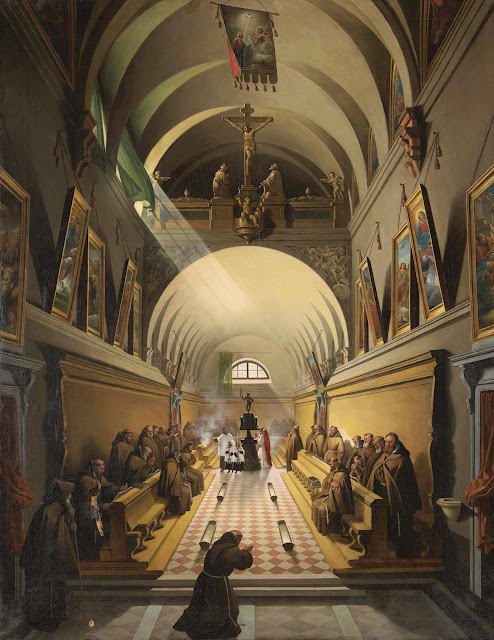Capuchin Convent by Francois Marius Granet
Granet spent his youth in Aix-en-Provence where he exhibited a precocious talent. He studied first at the École Gratuite de Dessin. While he was a student, his watercolor sketches depicted ruins, cloisters and of course, churches. Once in Paris he worked in a studio, developing his unique genre based on architectural interior. Since he was painting several churches and other ecclesiastical aspects, he gained the nickname of “the monk”.
And he eventually got to study in the cloister of the Capuchins in the Rue Saint-Honoré. He had his own cell at this convent, which had been serving as a manufactory place during the Revolution, and that was afterwards inhabited almost exclusively by artists. In the changing lights and shadows of the corridors of the Capuchins, Granet found inspiration for that one picture to which he devoted his life, achieving a successful personal genre.
During this time, he admired many old master paintings in the Louvre, getting a strong influence for his own architectural compositions and lighting. One of the first works he exhibited at the Paris Salon was an Interior of a Cloister shown in 1799. This particular work is known for its many replicas, and departing from there, Granet did several pieces inspired on the Capuchin way of life, such as Interior view of the Church and the Choir of the monastery, as well as today´s painting: Interior of a Capuchin Convent. In 1802, he left Paris for Rome, where he remained until 1819. As he he returned to Paris, he brought one of fourteen repetitions of his celebrated "Choir of the Capuchins," that was executed in 1811.
Granet conceived this subject during Napoleon's occupation of Rome. At that time, the Capuchin order had been banished from its seventeenth-century church, near piazza Barberini. Despite French policy, the painting was purchased by the Emperor's sister Caroline Murat, Queen of Naples.
He placed great attention to detail. The figures of the monks celebrating mass are take part of the architectural effect. Rather than painting traditional religious subjects, which had been in disfavor since the beginning of the Revolution, Granet expressed his own religious feelings by depicting places of spiritual meaning, surrounding the practice of religious rituals. Aside of their accuracy of detail, these compositions show dramatic lighting and complex perspectives.
Granet retired to Aix-en-Provence after the revolution of 1848, dying one year later in 1849.
The contents of his workshop, his drawings and other collections were donated to the city of Aix and now they form part of the Granet Museum.
This painting can be find in the Art Gallery of Yale University.


Comments
Post a Comment